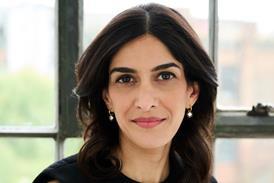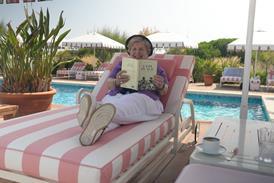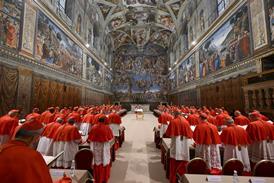Quantel Snell chief executive Tim Thorsteinson tells George Bevir why people and products are key to putting some energy back into the business following the merger of the two technology firms.

Tim Thorsteinson waves his business card at me. He’s unhappy with how long it has taken to combine Quantel and Snell since the companies merged.
“This says it all. To hand out a business card 15 months later with two brands on it, to have two email systems and so on, is an indictment. I am embarrassed to hand out that card,” he says.
Thorsteinson replaced Ray Cross, Quantel’s chief executive of 10 years, a year after Snell was merged with Quantel by the major backer of both firms, Lloyds Development Capital (LDC).
At the time, LDC managing director Chris Hurley said Thorsteinson had been appointed to “continue the company’s transformation”.
The man himself is typically more candid. “This isn’t IBM and Cisco - it is two relatively small businesses within a 30-mile radius, so put them together,” he says.
Honest assessment
Thorsteinson doesn’t pull any punches in his assessment of Quantel Snell.
When he joined the company as chief executive in March, it was, he says, just as he expected it to be: “A depressed, tired business with not a lot of energy in it; the kind of building where you walk out at the end of the day on all fours dragging your ass into the parking lot.”
The former Grass Valley, Thomson, Leitch and Harris Broadcast boss has developed a reputation as the Red Adair of the broadcast technology industry.
According to the press release that announced his arrival at Quantel Snell, he “has a proven track record of value creation”.
In Thorsteinson-speak, he takes the reins at businesses in need of a shot in the arm.
“This is the fourth time I have taken over a business that was in trouble,” he says, describing Quantel Snell as “a business living in the past”, with a management team “in a cocoon”.
Thorsteinson’s approach to boosting the performance of equipment vendors can be summed up as ‘people and products’.
At Quantel Snell, he started in his usual manner, by focusing on the former and asking HR for a list of the top 50 employees by pay.
“I begin at the top and figure out what they are doing, how they contribute to the business, and work my way down.
“Most of the top 10 on that list are no longer here. That’s not because they were bad people, it was just time to change.”
The one compliment Thorsteinson pays to the previous management is that they “did a good job on the cost structure”.
“Some turnarounds involve whacking a third of the costs out, and it performs better for a while. That isn’t what this is. To grow your business, you need to be bringing new and better technology to market at better price points.”
He estimates that around 70 people have been hired since he arrived, but that the headcount is “flat to up some” - with job losses in management and admin roles but a net increase in headcount.
The recruitment has focused on R&D, with approximately 15 to 20 additional engineers hired.
One focus involves combining its various product sets, which was spoken about when the merger was announced last year.
The suggestion was that Snell’s conversion technology could be used in Quantel’s IPbased workflow system, QTube, while Snell’s Momentum asset management system could be combined with Quantel’s news and sport production tools.
The first stage of integration between Momentum and Quantel products will be show at IBC.
“If Media Biometrics [Snell’s intelligent monitoring technology] shows up in the Quantel workflow product line, and if the media asset management solutions span the whole product offering - not just the TV everywhere piece - that’s the real leverage,” says Thorsteinson.
Aside from combining products, Thorsteinson wants growth to come from selling to new markets.
He describes the Snell Kahuna as “a great switcher” at the high end of the market, but points to universities and sports venues as potential customers of a cheaper system.
“It’s a market that if we had a product today we could sell to,” he says.
One area that holds less promise is post production, with Quantel’s Pablo and Pablo Rio grading and finishing systems facing stiff competition from suppliers at the “low end” of the market.
“I don’t see it as a growth area but we are investing in it because customers require it and it is a nice stable business,” he says.
Overseas expansion
Thorsteinson says Quantel Snell is considering opening a design centre in North America next year to be closer to customers in Canada and the US. Staffed by as many as 20 people, it would be tasked with design and applications for major customers in the area.
Part of Quantel Snell’s “realignment” of staff is concerned with boosting the company’s presence in developing markets.
“We had too many people in one region,” says Thorsteinson.
“Companies tend to be where the business used to be good, with less focus on where the business could be good. For example, we didn’t have much of a presence in the Middle East and supported Latin America from Spain.”
Technology shifts
Thorsteinson compares the focus on IP-based infrastructure to other big technology shifts when the broadcast world paused to consider what technology it should invest in.
In contrast to the relatively settled industry that grappled with the move from analogue to digital and SD to HD, today’s broadcasters’ and content owners’ business models are undergoing significant change, which has resulted in a reluctance to make major capital commitments.
That means, Thorsteinson says, they want more flexibility from the kit they buy.
“The market is very bifurcated,” he says. “We recently signed a £3m deal for a huge,traditional baseband installation. But at the same time, we have customers who want software-only playout solutions.”
Like all broadcast kit vendors, Quantel Snell’s task is to straddle the old and the new, with the timing of the launch of products a potentially “company-defining” challenge.
It also faces the challenge of a decline in significant revenue streams, such as routers, as kit becomes commoditised.
Quantel Snell’s new approach, which will be its focus at IBC, is to build its software business and move away from isolated products in favour of workflows, and to offer more in the way of integration.
The company’s new identity, which will be one of the final stages of the integration of the two technology firms, will also be unveiled at IBC.
And by the time the broadcast technology industry gathers in Amsterdam, Thorsteinson should have a fresh deck of newly-branded business cards to hand out.
Tim Thorsteinson on…
Joining Quantel Snell
“I have teenage kids, which means I am not retiring. The dog is tired of me and the problem with being a chief executive for all these years is you don’t have any hobbies… there is also some psychic income in taking something that has a lot of potential and a proud history and moving it into the future.”
Redundancies
“It’s been my time on a couple of occasions. When I ran Harris Broadcast, after seven years the owners had profi t expectations that I couldn’t achieve.
“We couldn’t come up with an answer how to make the business better, so guess what? It was my time.”
The importance of energy
“I can walk through a building and tell whether a business will make it or not. You can tell by the energy in the building; how people interact and whether you hear any laughter at all.”
Growth
“Growing businesses from a topline revenue standpoint will be very diffi cult for anybody [in this industry]. Price points continue to drop, commoditisation continues to occur, and it is very competitive.”


























No comments yet